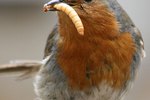
Looking at a box of mealworms it’s hard to imagine that they could do anything more than sit in one spot and eat whatever is given to them. While there’s a lot of truth in that, when they mature and turn into beetles they are suddenly very mobile. In this form they have the potential to do real harm to very small and young plants.
Basics
Mealworms are the larval stage of the darkling beetle. These small, pale worms are often raised as food for pets such as fish, reptiles and birds, or sometimes as a treat for wild birds and other wildlife. Once they hatch, mealworms molt repeatedly over the course of several months until they are about 1.37 of an inch long and are ready to pupate. They remain as pupae for about one to three weeks before emerging as adult darkling beetles, ready to eat and reproduce.
Captive Beetles
When raising mealworms in captivity, it’s necessary that some of them be allowed to transform into beetles so they can mature and lay eggs. They cannot fly and typically cannot get out of a container with straight sides that stick up more than an inch or two above the surface of their bedding. If any do escape they will be hard to catch under most circumstances, because they are extremely fast. Even if they get out, they aren’t likely to harm established houseplants. Darkling beetles are usually more of a problem in large numbers, especially outside around farms and gardens.
Diet
When raising darkling beetles it’s common to feed them chunks of cabbage, lettuce or slices of potatoes, oranges or apples. When they’re on their own they will usually eat rotting and decaying plants, but if they can’t find those they will eat grain or the tender young shoots of living plants. Farmers and gardeners sometimes have to contend with darkling beetles killing emerging crops by eating the outer layer of the stem or by cutting the plants off completely at ground level.
Control
Planted areas that show signs of darkling beetle infestation should be treated if the damage appears extensive. Sometimes that damage occurs only in small portions of a field and is limited to the plants around the outer edges -- in which case, it may not need treatment. If it does, the best insecticide for killing the darkling beetles is carbaryl, but care must be taken not to contaminate waterways with this chemical. Once plants are about 6 inches high they are usually safe from darkling beetles.
References
Photo Credits
-
Thomas Northcut/Photodisc/Getty Images




